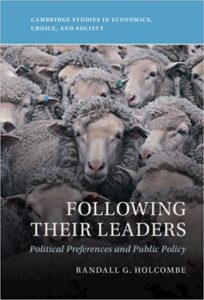So far in this exploration of Randall Holcombe’s Following Their Leaders: Political Preferences and Public Policy, we’ve looked at how Holcombe views the interaction of voters and the democratic process.

To briefly recap, Holcombe argues that voters have both instrumental preferences, which are about the outcomes they prefer, and expressive preferences, which are about what voters prefer to express. But expressive preferences and instrumental preferences are not always the same. Since casting a vote does not create an outcome, voters will tend to act expressively, not instrumentally, when casting their vote. Because elections aggregate expressive preferences, not instrumental preferences, we cannot make valid inferences about the outcomes voters actually prefer by referencing election results. Additionally, voter preferences tend to be anchored on a key point – a single issue, a political identity, party loyalty, a particular leader – and the vast majority of a given voter’s preference on political issues will be derived from that anchor. Someone may anchor on the identity of being a patriotic American, decide that the Republican party values patriotism more, and will then tend to adopt whatever the Republican party line is for most political issues – and if the official party line changes, they will change their opinion right along with it.
But this analysis so far focuses on the typical voter. There is another group of people in democratic political systems, who face different incentives and form their preferences in different ways. These are the elites – such as politicians, policymakers, bureaucrats, and lobbyists. Unlike the typical voter, the political preferences of the elites will tend to be instrumental rather than expressive, because elites actually do influence outcomes in a way voters don’t:
Holcombe argues that a relatively small group of elites are the ones who actually craft policies and influence political outcomes, with the vast majority of the population closed out from this process. He does not present this as some sort of nefarious, deliberate conspiracy among the elites to keep the masses disenfranchised. Instead, he argues, this is an inevitable part of any system of public policy, due to transaction costs:
However, transaction costs are not evenly distributed for all exchanges – some groups will face higher transaction costs than others. Groups facing low transaction costs can profitably participate in a system while groups facing high transaction costs will be unable to benefit. Pollution created by a steel mill provides a good outline of how this process works:
This uneven distribution of transaction costs exists in political systems as well. Well connected political insiders face low transaction costs in bargaining with each other over public policy. Meaningful negotiation over policy being carried out by tens or hundreds of millions of individual citizens simply isn’t feasible. But though markets and politics can both have unequal distributions of transaction costs, this issue tends to be more severe in political systems by their very nature:
This concentration of influence among a small group of elites is often protested by populists on the left and the right. However, Holcombe argues that because this situation exists due to unavoidable transaction costs, attempts to ouster the elites through populist takeovers are almost intrinsically self-defeating:
However, this does not mean that there is no division between instrumental and expressive preferences among elites. The division, however, operates differently among elites than it does with voters. While voters may show expressive preferences through voting for policies they wouldn’t actually choose if making an instrumental choice, elites will outwardly express policy ideas that don’t reflect the policies they pick when making instrumental choices:
The fact that voters have extremely low levels of political information has been well documented for decades. Huge swaths of voters will passionately support the Republican or Democratic political tickets yet, when questioned or tested, be utterly incapable of explaining the specific mechanisms by which their party’s policies will create desirable outcomes, or even telling which policies are associated with which party. Knowing that voters often “have only the vaguest idea about what they are supporting”, elites are deliberately vague about their intentions:
In the next post in this series, we will look at how this difference between the preferences of the elites and the preferences of voters come together to form Holcombe’s overall picture of the democratic process.


Comments are closed.